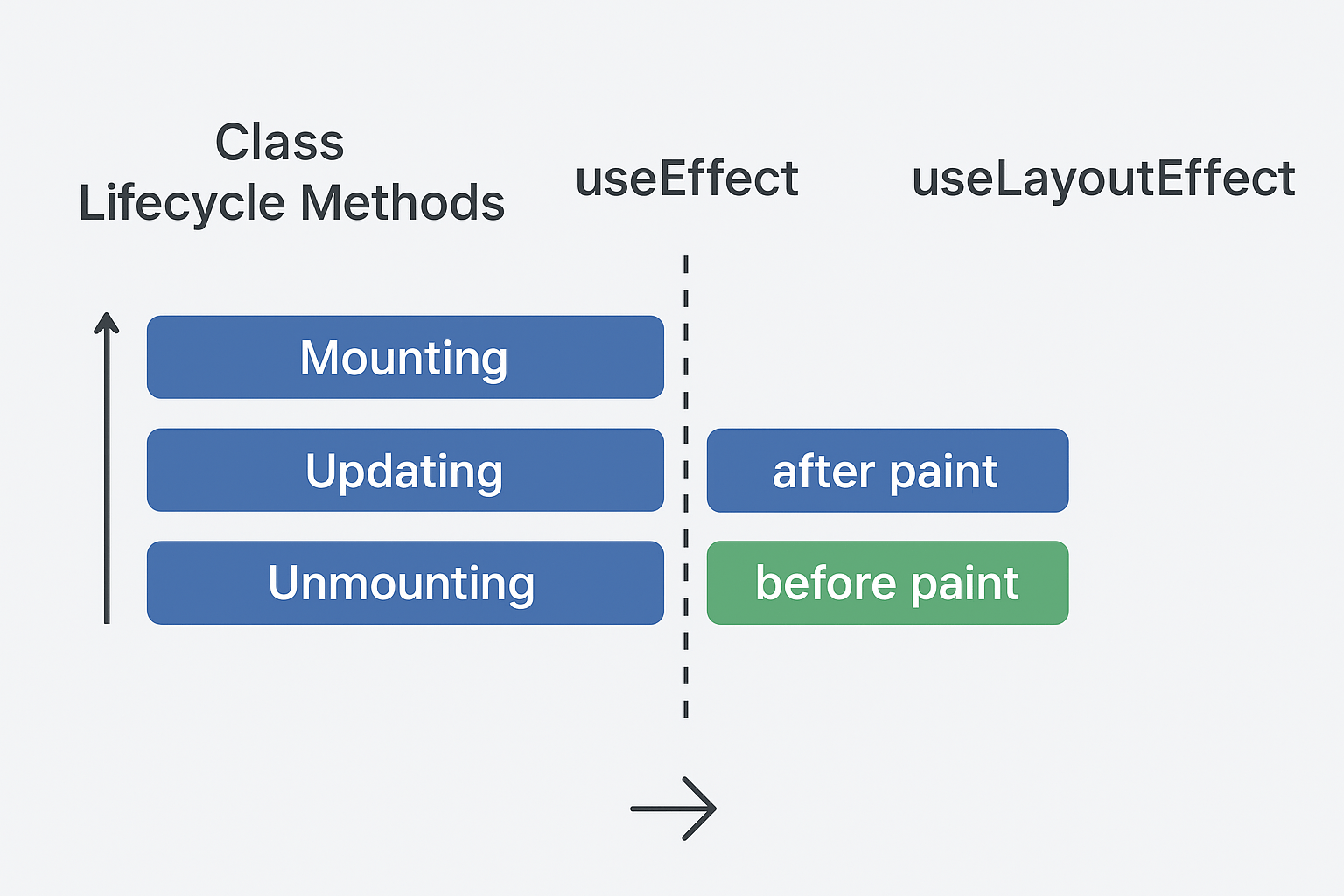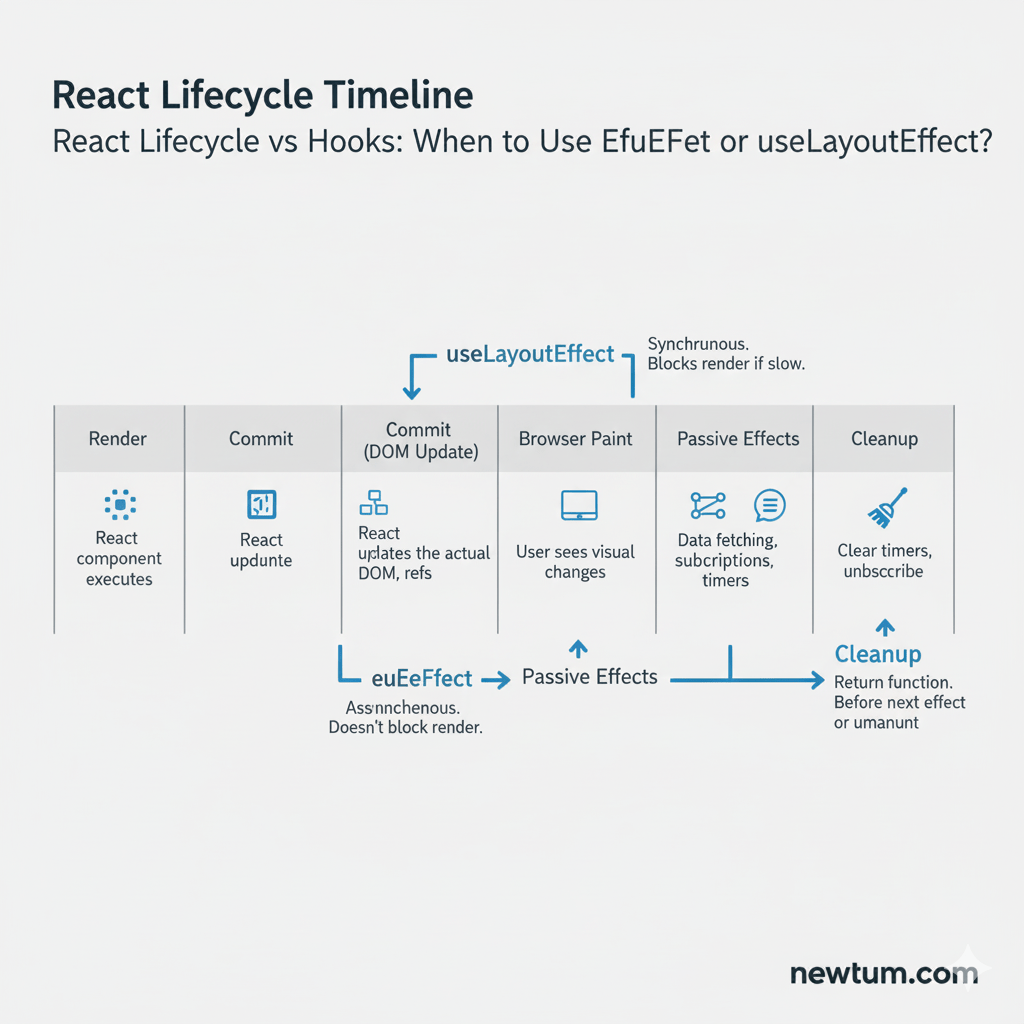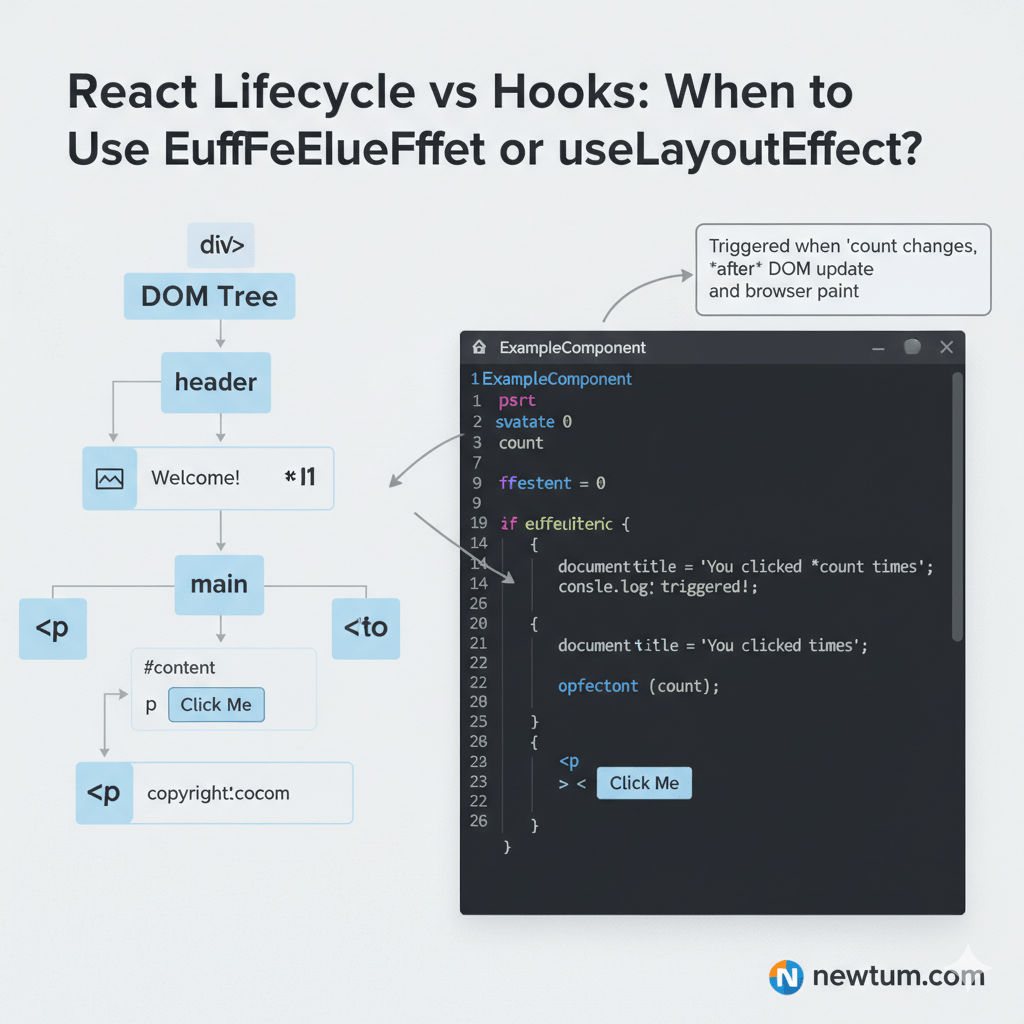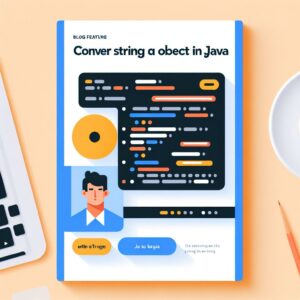React lifecycle methods in class components are largely replaced by hooks in functional components — primarily useEffect (for mounting, updating, cleanup) and useLayoutEffect (for layout-phase sync).
To choose between them, use useEffect for most side-effects and useLayoutEffect when you need to synchronously read layout (e.g. DOM measurements).
In today’s hook-centric React world, understanding React lifecycle vs hooks is essential. Many developers are moving from class components and need to avoid performance pitfalls. In this article, you’ll learn side-by-side comparisons, when to use useEffect or useLayoutEffect, and practical examples.
Quick Summary of React Lifecycle vs Hooks
For example:
| Context | Hook / Method | Usage / Behavior |
|---|---|---|
| Mount / Init | componentDidMount → useEffect(..., []) | ∙ Run once after first render |
| Update / Reaction | componentDidUpdate → useEffect(..., [deps]) | ∙ Runs when dependencies change |
| Cleanup / Unmount | componentWillUnmount → useEffect return callback | ∙ Clean up subscriptions, listeners |
| Layout sync | componentDidMount/componentDidUpdate for layout → useLayoutEffect | ∙ Runs before paint for DOM reads/writes |
What Are React Lifecycle Methods?
What are the mounting, updating, and unmounting phases in class components?
React class components go through distinct phases called lifecycle methods, which help developers control component behavior at different stages. These phases are:
- Mounting – When a component is created and inserted into the DOM. Key methods include:
constructor()→ Initialize state and bind methodsrender()→ Render the UIcomponentDidMount()→ Run code after component mounts (e.g., fetch data)
- Updating – When a component’s props or state change. Methods include:
componentDidUpdate(prevProps, prevState)→ Respond to updatesgetSnapshotBeforeUpdate(prevProps, prevState)→ Capture DOM info before the update
- Unmounting – When a component is removed from the DOM.
componentWillUnmount()→ Cleanup tasks like timers or subscriptions
- Other important methods
shouldComponentUpdate(nextProps, nextState)→ Decide if a re-render is needed
Why use lifecycle methods?
They are essential for managing side-effects, performing DOM operations, and handling cleanup tasks. Without them, it would be difficult to coordinate component behavior during mounting, updating, or unmounting.
How Hooks Changed the Paradigm

Why did React introduce hooks?
React introduced hooks to simplify component logic, making it easier to manage state and side-effects without relying on class components. This marked a conceptual shift: instead of splitting logic across multiple lifecycle methods, hooks let developers handle side-effects directly inside functional components.
With hooks:

useStatelets you manage component stateuseEffecthandles side-effects like data fetching, subscriptions, or DOM updatesuseLayoutEffectmanages layout-related operations before the browser paints
By moving away from class-based lifecycles, hooks make React code cleaner, more reusable, and easier to maintain, allowing developers to focus on what a component does, rather than when it does it.
Mapping Class Lifecycles to Hooks
componentDidMount, componentDidUpdate, componentWillUnmount → useEffect
In functional components, useEffect can replace most lifecycle methods. It runs after the component renders, and can also handle cleanup.

Example:
import { useEffect, useState } from 'react';
function ExampleComponent() {
const [count, setCount] = useState(0);
useEffect(() => {
// Runs after mount and on updates
console.log('Component mounted or updated');
// Cleanup function (replaces componentWillUnmount)
return () => {
console.log('Cleanup before next effect or unmount');
};
}, [count]); // dependency array
}
Key points:
- Dependency array controls when the effect runs. Empty array
[]→ run once on mount. Include variables → run when they change. - Cleanup function replaces
componentWillUnmount. - According to Stack Overflow,
useEffecteffectively replaces mounting, updating, and unmounting lifecycles.
When to Use useLayoutEffect
useLayoutEffect runs synchronously before the browser paints, unlike useEffect which runs after paint.
Use-cases:
- Measuring or modifying DOM layout
- Adjusting scroll positions
- Performing synchronous animations
Avoid overusing it — it can block paint and affect performance.
Example:
import { useLayoutEffect, useRef } from 'react';
function LayoutExample() {
const divRef = useRef();
useLayoutEffect(() => {
const height = divRef.current.offsetHeight;
console.log('Height before paint:', height);
}, []);
return <div ref={divRef}>Measure me!</div>;
}
Other Lifecycle Methods That Don’t Map Directly
Some class lifecycles require alternative hooks or patterns:
| Class Lifecycle | Hook Alternative / Pattern |
|---|---|
shouldComponentUpdate | React.memo, useMemo |
getSnapshotBeforeUpdate | useLayoutEffect |
| Error boundaries | useErrorBoundary or wrapper component |
These patterns allow functional components to achieve similar control without using class components.
Best Practices & Common Pitfalls
- Missing dependencies in
useEffect→ stale closures - Overusing
useLayoutEffect→ performance issues - Multiple
useEffectcalls vs single combined effect → balance readability & performance - Memory leaks if cleanup functions are not handled
- Batching state updates inside effects for efficiency
- Practical examples:
- Fetching API data + cleanup on unmount
- Timers and subscriptions
Following these best practices ensures smoother, predictable component behavior in functional React.
Real-Life Applications of React Lifecycle vs Hooks
Facebook: Improving News Feed Performance
Facebook, a leader in using React, optimizes the News Feed for better performance and maintainability. By switching from class-based lifecycle methods to hooks like useEffect, they improved component structure and reduced unnecessary re-renders.
import React, { useState, useEffect } from 'react';
function NewsFeed() {
const [posts, setPosts] = useState([]);
useEffect(() => {
fetch('https://api.facebook.com/posts')
.then(response => response.json())
.then(data => setPosts(data));
}, []);
return (
<div>
{posts.map((post, index) => (
<p key={index}>{post.content}</p>
))}
</div>
);
}
Output (example):
- “Just had coffee ☕”
- “React Hooks make life easier!”
- “Check out my new photo album!”
By using
useEffect, the News Feed updates efficiently whenever new posts are fetched, without extra lifecycle complexity.
Netflix: Enhanced User Recommendations
Netflix uses React to make recommendations dynamic and responsive. Hooks allow recommendation lists to update based on user interactions with minimal re-renders.
import React, { useState, useEffect } from 'react';
function Recommendations({ userId }) {
const [recommendations, setRecommendations] = useState([]);
useEffect(() => {
fetch(`https://api.netflix.com/users/${userId}/recommendations`)
.then(response => response.json())
.then(data => setRecommendations(data));
}, [userId]);
return (
<ul>
{recommendations.map((rec, index) => (
<li key={index}>{rec.title}</li>
))}
</ul>
);
}
Output (example):
- “Stranger Things”
- “The Witcher”
- “Money Heist”
Using
useEffectwith a dependency array ensures that updates occur only whenuserIdchanges, improving performance.
Instagram: Streamlined Image Loading
Instagram leverages hooks to manage image state, ensuring smooth scrolling and fast loading. By transitioning to functional components, large sets of images can be handled efficiently.
import React, { useState, useEffect } from 'react';
function ImageGallery() {
const [images, setImages] = useState([]);
useEffect(() => {
fetch('https://api.instagram.com/images')
.then(res => res.json())
.then(data => setImages(data));
}, []);
return (
<div>
{images.map((img, index) => (
<img key={index} src={img.url} alt={img.caption} width="200" />
))}
</div>
);
}
Output (example):
- Image of a sunset 🌅
- Photo of friends at a beach 🏖️
- Art illustration 🎨
Hooks allow Instagram to efficiently fetch and render images, improving user experience while keeping the code modular.
Pros & Cons of React Lifecycle vs hooks
| Approach | Pros | Cons / Limitations |
|---|---|---|
| Class Lifecycle Methods | Familiar, explicit lifecycle hooks | Verbose, this binding, harder to share logic, fragmentation of related logic |
Hooks (useEffect) | Cleaner, composable, split by concern, no this, more reusable logic | Risk of stale closures, dependency bugs, harder mental model for beginners |
useLayoutEffect | Synchronous DOM reads/writes, precise layout control | Can block paint, may cause flicker if misused |
React Lifecycle vs hooks Queries
So you’ve started exploring React, and you’ve heard all about React Lifecycle and Hooks, but you’re not quite sure how they stack up against each other? Let’s dive into some common questions to help clarify these concepts for you without getting bogged down by all the technical mumbo jumbo. Grab a cup of tea, and let’s get started!
- What’s the main difference between React Lifecycle methods and Hooks? React Lifecycle methods are like the blueprint you use to control what happens at different points in a component’s life from birth (mounting) to updates and death (unmounting). Hooks, on the other hand, let you use state and other React features without writing a class. They make React components simpler and less cluttered.
- Can Hooks replace all Lifecycle methods? Yes and no. Hooks can handle most tasks previously done with lifecycle methods, such as state management and side effects. However, you might face edge cases where lifecycle hooks are more suitable—for instance, when you need to manage more complex state logic over several lifecycle phases.
- Why were Hooks introduced if Lifecycle methods already existed? To reduce complexity! Hooks make the code easier to read and manage by avoiding those bulky class components. They offer a more functional approach that promotes cleaner code and reusability.
- How does useEffect differ from componentDidMount, componentDidUpdate, and componentWillUnmount? The
- Is there any limitation when using Hooks? Yes, you can’t use Hooks within class components. They’re exclusive to functional components. Also, Hooks should be called at the top level—not inside loops or conditions—to ensure consistent behavior across renders.
- What is a custom Hook, and when should I use one? A custom Hook is basically any function starting with “use” that can call other Hooks. Use them when you find repeated logic or stateful logic. They’re great for code reusability.
- Are there performance concerns with using Hooks? Generally, Hooks don’t negatively impact performance if used correctly. However, improper use like incorrect dependency arrays in
- How can I handle errors in Hooks as opposed to Lifecycle methods? Because Hooks lack a lifecycle method for error boundaries, you might use separate error boundary components to catch errors just like you would in class components. Error handling mainly stays the same.
useEffect Hook combines the power of all these lifecycle methods into one. You can perform side effects like fetching data or manually changing the DOM. With dependency arrays, you control when to run these effects.useEffect could lead to unwanted re-renders.These FAQs will get you on the right track, and provide insightful points of comparison without all the competitor coverage. Keep experimenting with both lifecycle methods and Hooks, as they each have their own strengths and situations for use.
Discover our AI-powered js online compiler, where you can instantly write, run, and test your code. Our intelligent compiler simplifies your coding experience, offering real-time suggestions and debugging tips, streamlining your journey from coding novice to expert with ease. Explore it today and boost your coding skills!
Conclusion
Completing ‘React lifecycle vs hooks’ provides a deep understanding of React’s components and state management, empowering you to create dynamic web applications effectively. Dive into this hands-on learning and feel accomplished! Explore more programming skills at Newtum to master languages like Java, Python, and more.
Edited and Compiled by
This article was compiled and edited by @rasikadeshpande, who has over 4 years of experience in writing. She’s passionate about helping beginners understand technical topics in a more interactive way.



